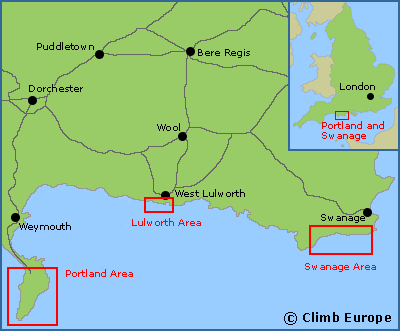Dorset Rock Climbing
Sport climbing and bouldering at Portland
Portland is well known as one of Britain’s best sport climbing venues. Circling the Isle’s lofty fringes are around 6km of virtually unbroken limestone cliffs, where almost 1,300 well-bolted routes have been developed. Most of the routes are single pitch up to 30m high, across a wide range of grades from F2 to F8b including many in the mid-grade range of F6a to F7c.
The style of climbing at Portland is on steep routes above the sea. They tend to be just off either side of vertical on jugs, crimps, pockets and glorious flow stone features – something that is not often found in Britain.
Map of the main rock climbing areas on the Dorset Coast

Portland is also a great bouldering destination that offers a diverse selection of settings and problems. The style of bouldering varies from smooth and fine-grained to rough and wave-washed limestone rock. The largest bouldering area on Portland is at the Cuttings which is an extensive area running from the cliff base all the way down to the sea.
The style of the bouldering at the Cuttings includes everything from crimpy walls, delicate slabs, hand cracks, roofs, sharp aretes, to long traverses, plus technical and powerful problems – something for everyone. Here there are around 600 problems, across a wide range of grades from Fb3 to Fb7b. The vast majority of these problems are below Fb6c, making the Cuttings an excellent place for the lower to mid-grade boulderer. Most of the blocs are short in statue with many of the problems beginning with sit-starts. The Rockfax Dorset Bouldering Guidebook covers all the bouldering on Portland.
Portland has a very mild climate which makes it an ideal venue for being able to climb all year round, since there is limited seepage and lots of sunshine in the winter months. The east and west aspects of the cliffs means that you can find the sun at some point all day during the winter and shade in the summer. Also unlike most sea cliffs, tides are not an issue as most cliffs are situated high above the high tide mark.
Rock climbing at Swanage
The rock climbing at Swanage is certainly varied and with limestone sea cliffs that run unbroken for 5km it offers a unique climbing experience. With over 750 routes you will find adventurous trad climbing, friendly trad climbing, sport climbing and deep water soling (DWS).
Historically Swanage is known for its adventurous trad climbing where it is necessary to abseil down to ledges around 5m above the sea - the classic area being the Boulder Ruckle. This style of climbing is over rugged terrain that is steep with many overhangs and roofs that are as good as anywhere else in Britain. However it is possible to find some friendly trad climbing areas such as Subluminal and the Cattle Troughs, where there are many easier routes.

The above photograph shows Hayley Stokes on a classic Portland crimpfest.
Some of the most popular areas at Swanage are the bolted quarries at Dancing Ledge, Hedbury and Winspit with their wide range of sport routes. During the summer months, Swanage is also great for its deep water soling (DWS) at places such as Connor Cove.
Close to Swanage, the bouldering at St Aldhelm’s Head offers a wide range of problems from Fb3 to Fb7b+. There are many problems in the lower grades, and the bouldering offers bags of character, with a mixture of easily accessible old-school quarried edges and a wild, rough boulderfield by the sea.
Rock Climbing at Lulworth
Lulworth is famous for its fantastic overhanging faces above through-caves that make it a world class deep water soling (DWS) venue, especially at Stair Hole. There are other crags that offer mainly sport climbing, though these routes tend to be in the higher grades.
The Climber’s Club and Rockfax both publish extensive climbing guidebooks for Dorset. The Climbers’ Club have separate guidebooks for Portland and Swanage that also includes the bouldering. Rockfax’s Dorset guidebook covers all the rock and sport climbing, whilst they have published a separate guidebook for the bouldering, call Dorset Bouldering. Buy all of these Dorset climbing guidebooks from our shop.